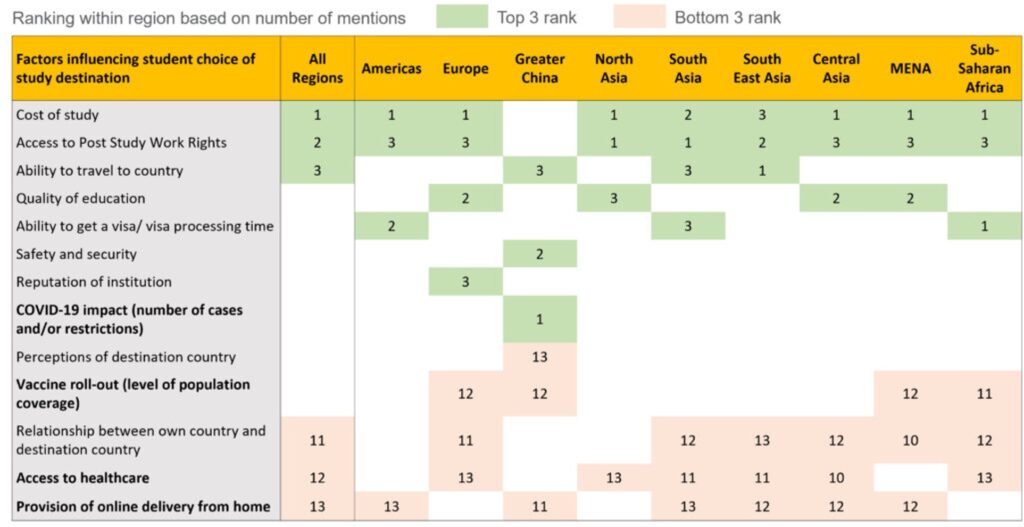
Behind the headlines, the federal budget reveals some good news for international education
Last Tuesday evening, the Hon Josh Frydenberg delivered his budget speech for 2022-2023. The speech focused on key issues facing Australian society and its economy in the lead up to the Federal election. However, there was a limited focus on higher education and almost no focus on international education. Despite no specific budget measures for international education providers or students, the detail that sits in the budget papers reveal welcome news for the sector.
Headline net migration and international student figures will take a few years to return
COVID-19 and the associated border closures have had an unprecedented impact on Australia’s Migration program and are expected to have a long-term impact on population growth and Australia’s economy.
While February’s re-opening of the borders has resulted in forecast Net Overseas Migration (NOM) increasing from -40,000 to +40,000 for 2021-22, it is still expected that overall NOM will not return to pre-pandemic levels until 2025-26.[1] This will have significant implications for the skills needs of the Australian economy due to the absence of young, highly skilled migrants entering Australia’s workforce.
International students represent a key contributor to levels of NOM. The budget assumes the sector’s export value will not return to pre-pandemic levels before June 2024.[2]
Figure 1: Budget forecasts for education exports (reproduced from Budget Paper 1)
But, in good news for international students and the economy, Australia will increase its intake of skilled migrants in 2022-23 by almost one-third
The budget includes an increase in the number of skilled migrants that will be supported through the Migration Program.
While the overall ceiling will remain at 160,000 migrants for 2022-23, the composition of the program will change with more places set aside for skilled streams. Almost 30,000 more people will be able to gain permanent residency through the skilled stream than forecast for 2021-22 – a one-third increase in skilled migrants in Australia next year.[3] Skilled migrants will make up more than 70% of the program (up from 50% in previous plans released by the government).
Australia’s Migration Program provides an important and attractive pathway for international students to establish their lives in Australia. This increase in skilled migrant numbers should be welcomed by the sector because it is the most used pathway for international students looking to settle permanently in Australia.
This will be supplemented by a further increase in the Migration Program in 2023-24
The budget papers also outline the overall ceiling for the program will be raised to 190,000 for 2023-24 – a return to planning levels not seen since prior to the pandemic. Again, this is good news for international students, as well as for the Australian business community. If the skilled migrant proportion holds (at 70%) this would see the number of skilled migrants grow 66% compared to previously planned levels.
Navitas has advocated for an increase in the overall scale of the migration program, as have a number of business and commerce groups in order to address skilled shortages in the economy – including the Australian Chamber of Commerce and Industry, the Business Council of Australia and the AI Group. This change is therefore very welcome.
Opportunities for post-study employment are important for international students choosing to make Australia their home
For most students that come to Australia for study, their intention is to stay for a period to access high quality study and work, before ultimately heading back home. However, around one-in-six former students will transition following their studies to become skilled migrants (typically after a period on other temporary visas). Accessible pathways, including through post-study work rights is important to prospective students. Indeed, the most recent Navitas Agent Perception Survey found access to post-study work rights remains a top 3 factor influencing a student’s choice of where to study.
Figure 2: What are currently the most important factors influencing student choice of study destination (Navitas Agent Perception Survey, October 2021)
This research has shown a decline in perceptions of Australia as an attractive international education destination, particularly with regard to being ‘open and welcoming’. This budget is a positive sign of Australia’s migration settings becoming more welcoming and provides an additional pathway for students that may wish to migrate to Australia.
Figure 3: Over the past two months, the reputation of this country as open and welcoming for international students has improved. (Navitas Agent Perception Survey, October 2021)
International students make the best migrants – further changes to the program could support opportunities for international students and contribute to Australia’s economy
International students are among the best migrants for Australia – they are young, highly educated, have high earning potential, make strong economic contributions, and have a strong affinity with Australian values due to their educational and work experience in Australia.[4] The Migration Council of Australia has demonstrated that among migrants, students make the most significant contribution to Australia’s prosperity – contributing a GDP premium of 30% per migrant compared to 22-23% for temporary skilled and Skilled Independent visa holders.[5] Students and graduates therefore represent a ready pipeline of highly qualified, talented, and young, skilled migrants to Australia. While the shift towards more skilled migration places is very welcome and a positive move for students, more can be done to attract these best and brightest to stay in Australia and continue to contribute to Australian society. Changes to the points-based system, explicit targets on student transitions to PR and careful reconsideration of the ‘temporary entrant’ requirements for students are all areas that should be considered.
Increasing the levels of skilled migration is a positive step towards Australia opening back up, but further changes are needed for Australian society and economy to truly benefit from our international students.
More details on Navitas’ proposal for the Migration Program can be found in our Submission to the Joint Standing Committee on Migration’s Inquiry into Australia’s skilled migration program.
———————————
[1] Navitas (2021) ‘Submission to the Joint Standing Committee on Migration’s Inquiry into Skilled Migration’.
[2] Migration Council of Australia (2015), “The Economic Impact of Migration”,
[3] Commonwealth of Australia (2022) ‘Budget Strategy and Outlook: Budget Paper No. 1’
[4] AFR (2022) ‘Net migration to hit 235,000 a year by 2025’
[5] Commonwealth of Australia (2022) ‘Budget Strategy and Outlook: Budget Paper No. 1’






